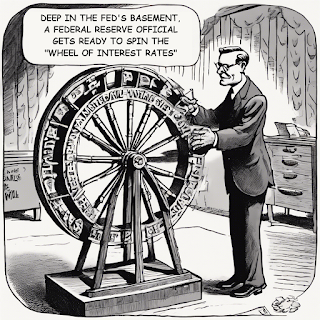The odds the U.S. economy will see a recession start at sometime in the next twelve months continued to rise during the past six weeks. Since our previous update, that probability has risen a couple of notches to just over 76%. This resurgence began after the recession probability bottomed at 67% at the end of November 2023 after having previously peaked at 81% in July 2023. The rebound in the odds of recession is nearing what might be described as a double-top.
These probabilities are based on a recession forecasting method developed for the Federal Reserve Board in 2006. As such, they reflect the kind of real data that Federal Reserve officials will be weighing as they meet from 19-20 March 2024 to discuss how they will be setting short term interest rates in the United States.
The prospect for recession has ticked up since bottoming largely because the inversion of the U.S. Treasury curve deepened since December 2023, with longer term interest rates falling further below the level of short term rates. That change has coincided with reports of higher-than-expected inflation prompting Fed officials to delay the beginning of expected interest rate cuts by at least three months.
The following chart presents the latest update of the Recession Probability Track, capturing how that probability appears going into the Federal Reserve's second two-day meeting of 2024. The Fed's Federal Open Market Committee is expected to continue holding the Federal Funds Rate steady at this meeting. The Fed is expected to start lowering this core interest rate at later meetings in 2024, with markets currently anticipating the Fed will act to cut rates at its June 2024 meeting.
The Recession Probability Track indicates the probability a recession will someday be officially determined to have begun sometime in the next 12 months. For this update, that applies to the dates between 18 March 2024 and 18 March 2025.
The probability of recession peaked at nearly 81% on 25 July 2023, making the period from July 2023 through July 2024 the mostly likely period in which the National Bureau of Economic Research will someday identify a point of time marking the peak in the U.S. business cycle before it entered a period of contraction. The prolonged elevation of the Federal Funds Rate combined the deepened inversion of the U.S. Treasury yield curve in recent weeks has made the period between 18 March 2024 and 18 March 2025 the second most-likely period that will include the peak of a business cycle that marks when a recession began.
Analyst's Notes
The Recession Probability Track is based on Jonathan Wright's yield curve-based recession forecasting model, which factors in the one-quarter average spread between the 10-year and 3-month constant maturity U.S. Treasuries and the corresponding one-quarter average level of the Federal Funds Rate. If you'd like to do that math using the latest data available to anticipate where the Recession Probability Track is heading, we have provided a tool to make it easy to do.
We will continue to follow the Federal Reserve's Open Market Committee's meeting schedule in providing updates for the Recession Probability Track until the U.S. Treasury yield curve is no longer inverted and the future recession odds retreat below a 20% threshold.
For the latest updates of the U.S. Recession Probability Track, follow this link!
Previously on Political Calculations
We started this new recession watch series on 18 October 2022, coinciding with the inversion of the 10-Year and 3-Month constant maturity U.S. Treasuries. Here are all the posts-to-date on that topic in reverse chronological order, including this one....
- U.S. Recession Probability Nears a Double-Top
- Probability of U.S. Recession Resurges to Nearly 75%
- U.S. Recession Odds Recede to Two Out of Three Chance in 2024
- U.S. Recession Probability Continues Receding on All Hallow's Eve
- U.S. Recession Probability Starts to Recede
- Probability of Recession Starting in Next 12 Months Breaches 80%
- U.S. Recession Probability on Track to Rise Past 80%
- U.S. Recession Probability Reaches 67%
- U.S. Recession Probability Shoots Over 50% on Way to 60%
- Recession Probability Nearing 50%
- Recession Probability Ratchets Up to Better Than 1-in-6
- U.S. Recession Odds Rise Above 1-in-10
- The Return of the Recession Probability Track
Image credit: Stable Diffusion DreamStudio Beta. Prompt: "An editorial cartoon of a Federal Reserve official spinning a carnival wheel to set interest rates."
Labels: recession forecast
Welcome to the blogosphere's toolchest! Here, unlike other blogs dedicated to analyzing current events, we create easy-to-use, simple tools to do the math related to them so you can get in on the action too! If you would like to learn more about these tools, or if you would like to contribute ideas to develop for this blog, please e-mail us at:
ironman at politicalcalculations
Thanks in advance!
Closing values for previous trading day.
This site is primarily powered by:
CSS Validation
RSS Site Feed
JavaScript
The tools on this site are built using JavaScript. If you would like to learn more, one of the best free resources on the web is available at W3Schools.com.

